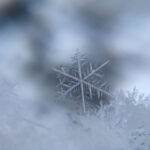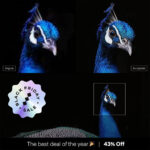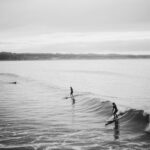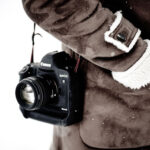There is some controversy around using HDR. This stems from the presentation of some HDR images done badly and the somewhat difficult processing of the image for the average photographer to get the desired results.

Photo by Justin Kern
The human eye can adjust to deep shadows and overly bright light quite quickly. The perception of the total image includes information from the deep shadows as well as detail from the bright highlights. We have been somewhat spoiled in the past using negative color film for our daily pictures. This method uses the adjustments from the camera’s original exposure and the exposure adjustments in the printing process to compress the wide band of detail into a viewable photograph. Along with this process comes a loss of detail in both the shadows and the highlights. Slide film like Kodachrome had a wider dynamic range but was less forgiving in producing a perfect exposure. Digital cameras have a similar characteristic.
In the early years of photography, the problem of dynamic range (the lack of) was solved by photographers like Ansel Adams in several ways. He used silver-based negative glass plates which had a decent dynamic range. The printing paper could not display nearly as much detail as was available on the negative. This was solved quite well by using a printing box with a couple of dozen small lamps that could be switched on or off individually. This manipulation supplied less light for the shadows and more to the highlights to produce a print that displayed detail in both areas. Contrast was controlled by warming the chemicals in the shadows and diluting the chemicals in the highlights. In the 1970s I used variable contrast printing paper to achieve similar results. I held back the shadows with a violet filter, lightening the dark areas while increasing the contrast to a viewable level. The highlights I burned in with a yellow filter in order to print down the overexposed highlights without raising the contrast unduly. Of course, this only worked with black and white photography.

Photo by Thomas Smart
Other methods that can be used are light painting (shining a moving spotlight on dark areas with the shutter open), using extra strong lights for dark areas and using gobos (movable shades) to hide light for very light toned areas. Commonly open flash on the camera is extensively used to open up shadows. Unfortunately, this presents a very flat light source, diminishing the beauty of light modeling.
In today’s world, a digital camera acts similarly to the old Kodachrome in respect to dynamic range. Overexposed highlights like a bright sky simply burn out, displaying as pure white in the photograph. All cloud and sky detail is missing. In underexposed shadows, contrast is low and much detail is lost in the dark murk. Additional overall exposure would help the shadow detail but would make the highlights even more blown out. HDR solves this problem, at least with non-moving subjects, by combining the information from three or more images photographed in increasing steps of exposure. If there is plenty of light, some digital cameras can take three photographs at differing exposures quick enough to prevent blurring without using a tripod. The best information from the highly exposed images is combined in the computer with the well-balanced information from the properly exposed highlight areas to produce a photograph that displays all the information you can see with your eyes.

Photo by Harry Pammer.
HDR software is available from several sources costing from between fifty and one hundred dollars. Advanced computer buffs can take advantage of their DSLRs with their RAW capabilities and high-resolution numbers to create beautiful landscapes and portraits. I envision future digital cameras with built-in HDR capability. They already can take three to five images at graded exposure steps. All that is needed is the HDR software. Presently I am experimenting with Dynamic Photo HDR and find it fairly easy to learn. The key seems to be paying attention to creating the proper range of exposures to get the desired results. Many other artistic tools can be applied to the HDR image like brushwork, highlight enhancement, and increased color saturation.
Like anything else, initial enthusiasm for HDR can lead to the overuse of the process, leading to unnatural looking photographs. Just as in life, moderation is key to using the tool of HDR to create beautiful photographs.
About the Author:
Kenneth Hoffman is a retired portrait and wedding photographer. He enjoys writing how-to articles and helpful articles on photography and many other subjects. His hobbies include quartet singing, bicycling, and photography.
Like This Article?
Don't Miss The Next One!
Join over 100,000 photographers of all experience levels who receive our free photography tips and articles to stay current:






I always thought photography was a personal matter and not something you went out of your way to please those looking at your images. There is nothing wrong with others criticizing and offering hints and tips on how your images could be improved, but to outwardly say that the image is bad, or an “HDR image done badly“, when the intention of the photographer was “to get the desired results”.
If the desired results are what the photographer was after and they have achieved it using HDR software then the opinion of those negatively condemning the result seems rather self opinionated.
Hmm, sorry but this looks exactly something I’d call a HDR. Look at the halos around the main subject, a signature of an overly HDR processed photo:
http://nichollsphoto.com/album/rusty/slides/Transtar%204200.html
I like your work, but as some of the others that posted here not too keen on photos that few clicks in plugins like Nik HDR FX Pro or PS HDR would produce in an instant and at the same time affecting the original natural tonal range.
Then again, horses for courses. Some like it ‘au naturel’ some tone-mapped and HDR’ed. Peace to all, everybody should do what you enjoy doing and what brings you the most satisfaction and fulfilment.
My photos may well be BORING to you, but they are at least real. They show the colors and tones that were there in the first place, not artificially added and enhanced. You won’t be the first HDR ‘art creator’ who finds other people’s photographs boring.
They simply don’t have the level of tone and color enhancements that people who are almost exclusively into HDR would find interesting.
Unsavoury a new term? How about garish?…would that be somewhat an easier term to relate to with HDR?
“Technically they aren’t HDR by the way..”
Really? So what are they then, Judith? A “tone mapped” images so much so that they don’t look as real anymore?
It’s funny how many people hide behind excuses for a HDR processing.
Your answer is exactly what I’ve been talking about. Let’s see your photos. No doubt I would call them BORING. Technically they aren’t HDR by the way. Unsavory. That’s a new one!
Uh, oh…you may call that art, for me it’s just an over-processed photography. Sorry but some of your photos border on unsavoury. Tone mapping is one thing but over done HDR is just that.
I guess what I’m trying to say is not being understood. I didn’t mean ME, I meant the habit of photographers of maligning other photographers who don’t do exactly the type of photography that they do. Let’s live and let live. I enjoyed the article but didn’t feel it added to it to talk about “bad” photography. We can encourage all of us to do better without that.
I think HDR has been in the learning stage and we photographers playing around with it because of the miracle of seeing those things we never saw from the camera. Of course, it is not new in that Ansel Adams was expert at tonemapping B&W and this article discusses the old techniques as well. With color film, apparently the desire to do such things disappeared because of the difficulty – until digital. I’m in hog heaven compared to film! I love being able to get much closer to what I saw or my vision of what I saw than I could with film.
As for me, I don’t do much HDR from multiple images, but I do a lot of tone mapping. Mostly to bring out the sky. I also like bright colors and to bring out textures.
Website:
http://nichollsphoto.com/
Here’s a tone-mapped one for sky:
http://www.nichollsphoto.com/album/West/slides/Cottonwood%20Pass.html
This one is tone-mapped and “gritty” because it fits the image:
http://nichollsphoto.com/album/rusty/slides/Old%20Truck.html
Judy
Agree with Kenny…please put your money where your mouth is, Judith…so to speak ;-)
Judy could you show us some of your HDR photos, please?
They may well be a nicely done and enhanced photos. It also may help to put the “bad vs liked HDR” argument discussed here, to bed.
Thanks,
Kenny
HDR images are tonemapped when they go to a form that can be viewed or printed. However, there are other ways of tonemapping. Modern tools such as Lightroom are tonemapping when you adjust the highlights, shadows, whites and blacks (LR4). There are many many other tools that can do it. Also, HDR does not require multiple images — all of the hDR programs I’m aware of can take in a single RAW or even a JPG and tonemap them.
How surreal someone makes a tone-mapped image is to their taste (and skill with the tools). Some people like the surreal look and I am unwilling to say it is “bad”. It is certainly different from SOOC.
Many modern cameras can do tone mapping in the camera itself. They can take the bits from the sensor and process them to spit out a tonemapped jpg. (RAW of course is not processed in the camera.) Hence you can have a kind of HDR (or tone-mapped) image that is SOOC.
BTW, very few SOOC images impress me… To each his or her own.
Untastefulness is also in the eye of the beholder. When a painter paints in bright unrealistic colors, no one calls it “untasteful” or “unnatural” simply because of that. However, when a photographer processes images in such a way, it is common to call it “untasteful” or “unnatural.” Why do photographs have to look “natural”? From the very beginning of photography photographers were trying to expand the horizon of photography from the “natural”.
My goal is to show people something that maybe they didn’t notice themselves. In order to do that I enhance the photograph in various ways in order to accentuate what I’m trying to show. This is what art is all about, in my opinion, not to simply reproduce what anyone can see.
Can we just agree to talk about what we like and what we don’t like? We can even talk about why we don’t like a particular image or how we think it could be improved (from our point of view). But to just say “bad” or “untasteful” is not useful in the dialog.
So let’s talk about what we don’t like about HDR? Not just say they are “bad” or “untasteful” or “unnatural”. Abstract paintings are certainly “unnatural” but no one says that people should not paint abstracts…
Judy
I have seen many HDRs and only a very few impress me, the vast majority, good or bad, I just do not like. Would rather see Tone Mapped pieces as they look more real. Just not a fan of HDR
Judith, there are indeed a majority of HDR photos done “badly” there’s no other word to describe them. You may like or not as you say, but bad HDR photo is just that – a bad photo.
The reason being is that with such a powerful tool like a HDR software many who are inept to using it simply overdo it to the level of un-tastefulness.
That said, there are also many HDR photos that I like, but those are the photos with a much more thought, taste and ‘slider control’ that went into them. Trey Ratcliff is one of them. Again, some despise him and his ‘art’ dismissing it as an unnatural looking “bad photography”, but I (and many others) actually like it.
“HDR images done badly “. Of crouse HDR can be used to create what our eyes see (as opposed to what the camera sees), but why oh why do so many such articles have to malign people with a different artistic view. There is of course a great tradition in art of criticizing anything different from what is standard at the time… and often it becomes embarrassing after some time has passed (impressionism, abstract painting). My trouble with these criticisms is often there is no reason for them. You could have discussed exactly the same thing without talking about “HDR images done badly.” Some people have the good taste to say much of HDR is not to their taste, which is totally different from calling it bad. There is a lot of art that I don’t personally like, but that’s what I say about it. I don’t like it, not that it is bad art.